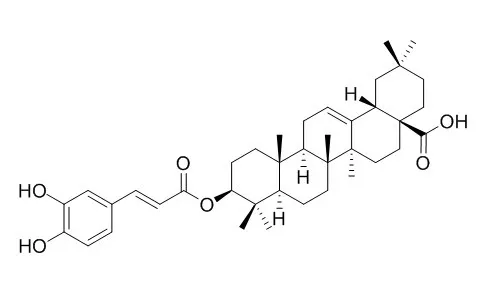| In vitro: |
| Planta Med. 2000 Jun;66(5):485-6. | | Cytotoxic triterpenes from stem bark of Physocarpus intermedius.[Pubmed: 10909277] |
METHODS AND RESULTS:
Seven triterpenes (1-7), i.e., betulinic acid 1, ursolic acid 2, oleanolic acid 3, 3-O-Caffeoyloleanolic acid 4, euscaphic acid 5, 2 alpha-hydroxyursolic acid 6 and maslinic acid 7 were isolated from the stem bark extract of P. intermedius as active principles responsible for the cytotoxicity against five cultured human tumor cell lines, i.e., A549 (non small cell lung), SK-OV-3 (ovary), SK-MEL-2 (melanoma), XF498 (central nerve system) and HCT-15 (colon), in vitro. | | Molecules. 2014 Jul 4;19(7):9515-34. | | Studies on cytotoxic constituents from the leaves of Elaeagnus oldhamii Maxim. in non-small cell lung cancer A549 cells.[Pubmed: 25000464 ] | Elaeagnus oldhamii Maxim. is a commonly used traditional herbal medicine. In Taiwan the leaves of E. oldhamii Maxim. are mainly used for treating lung disorders. Twenty five compounds were isolated from the leaves of E. oldhamii Maxim. in the present study.
METHODS AND RESULTS:
These included oleanolic acid (1), 3-O-(Z)-coumaroyl oleanolic acid (2), 3-O-(E)-coumaroyl oleanolic acid (3), 3-O-Caffeoyloleanolic acid (4), ursolic acid (5), 3-O-(Z)-coumaroyl ursolic acid (6), 3-O-(E)-coumaroyl ursolic acid (7), 3-O-caffeoyl ursolic acid (8), 3β, 13β-dihydroxyolean-11-en-28-oic acid (9), 3β, 13β-dihydroxyurs-11-en-28-oic acid (10), uvaol (11), betulin (12), lupeol (13), kaempferol (14), aromadendrin (15), epigallocatechin (16), cis-tiliroside (17), trans-tiliroside (18), isoamericanol B (19), trans-p-coumaric acid (20), protocatechuic acid (21), salicylic acid (22), trans-ferulic acid (23), syringic acid (24) and 3-O-methylgallic acid (25). Of the 25 isolated compounds, 21 compounds were identified for the first time in E. oldhamii Maxim. These included compounds 1, 4, 5 and 8-25. These 25 compounds were evaluated for their inhibitory activity against the growth of non-small cell lung cancer A549 cells by the MTT assay, and the corresponding structure-activity relationships were discussed. Among these 25 compounds, compound 6 displayed the best activity against the A549 cell line in vitro (CC50=8.56±0.57 μg/mL, at 48 h of MTT asssay). Furthermore, compound 2, 4, 8 and 18 exhibited in vitro cytotoxicity against the A549 cell line with the CC50 values of less than 20 μg/mL at 48 h of MTT asssay.
CONCLUSIONS:
These five compounds 2, 4, 6, 8 and 18 exhibited better cytotoxic activity compared with cisplatin (positive control, CC50 value of 14.87±1.94 μg/mL, at 48 h of MTT asssay). The result suggested that the five compounds might be responsible for its clinical anti-lung cancer effect. |
|






 Cell. 2018 Jan 11;172(1-2):249-261.e12. doi: 10.1016/j.cell.2017.12.019.IF=36.216(2019)
Cell. 2018 Jan 11;172(1-2):249-261.e12. doi: 10.1016/j.cell.2017.12.019.IF=36.216(2019) Cell Metab. 2020 Mar 3;31(3):534-548.e5. doi: 10.1016/j.cmet.2020.01.002.IF=22.415(2019)
Cell Metab. 2020 Mar 3;31(3):534-548.e5. doi: 10.1016/j.cmet.2020.01.002.IF=22.415(2019) Mol Cell. 2017 Nov 16;68(4):673-685.e6. doi: 10.1016/j.molcel.2017.10.022.IF=14.548(2019)
Mol Cell. 2017 Nov 16;68(4):673-685.e6. doi: 10.1016/j.molcel.2017.10.022.IF=14.548(2019)